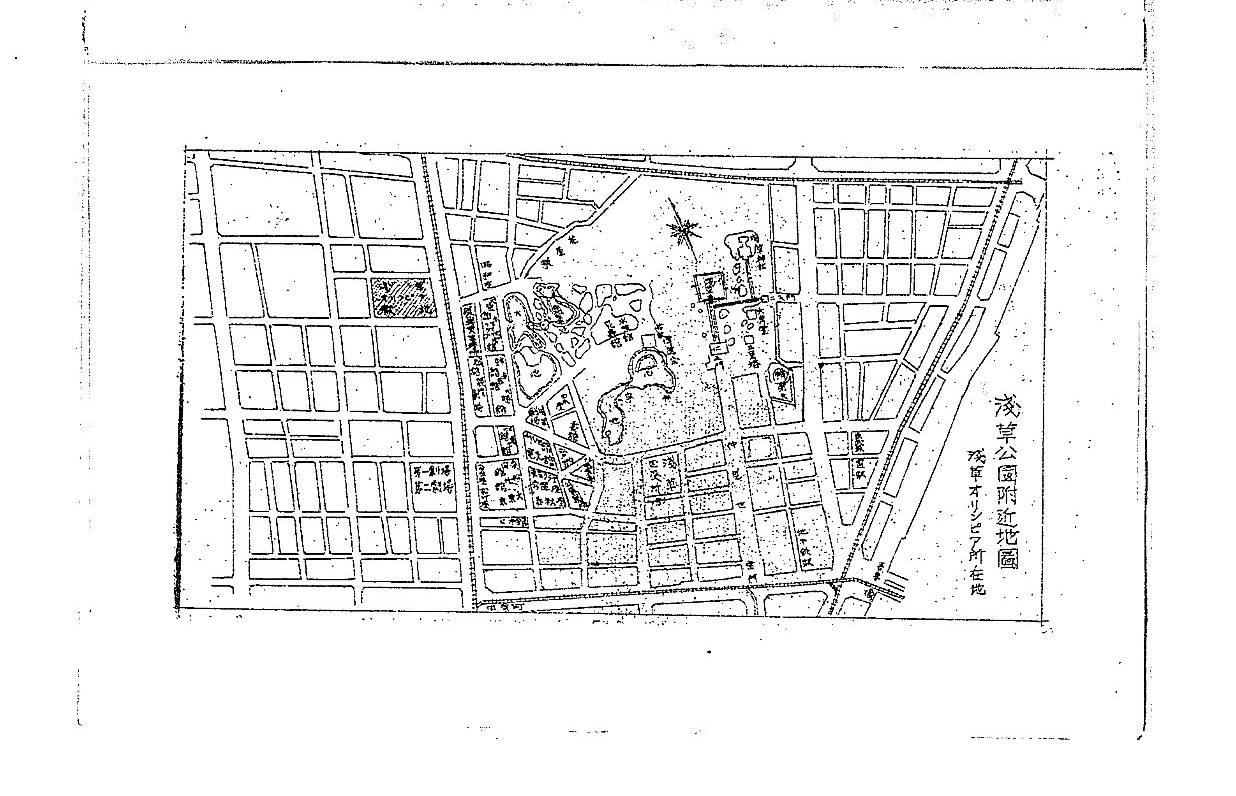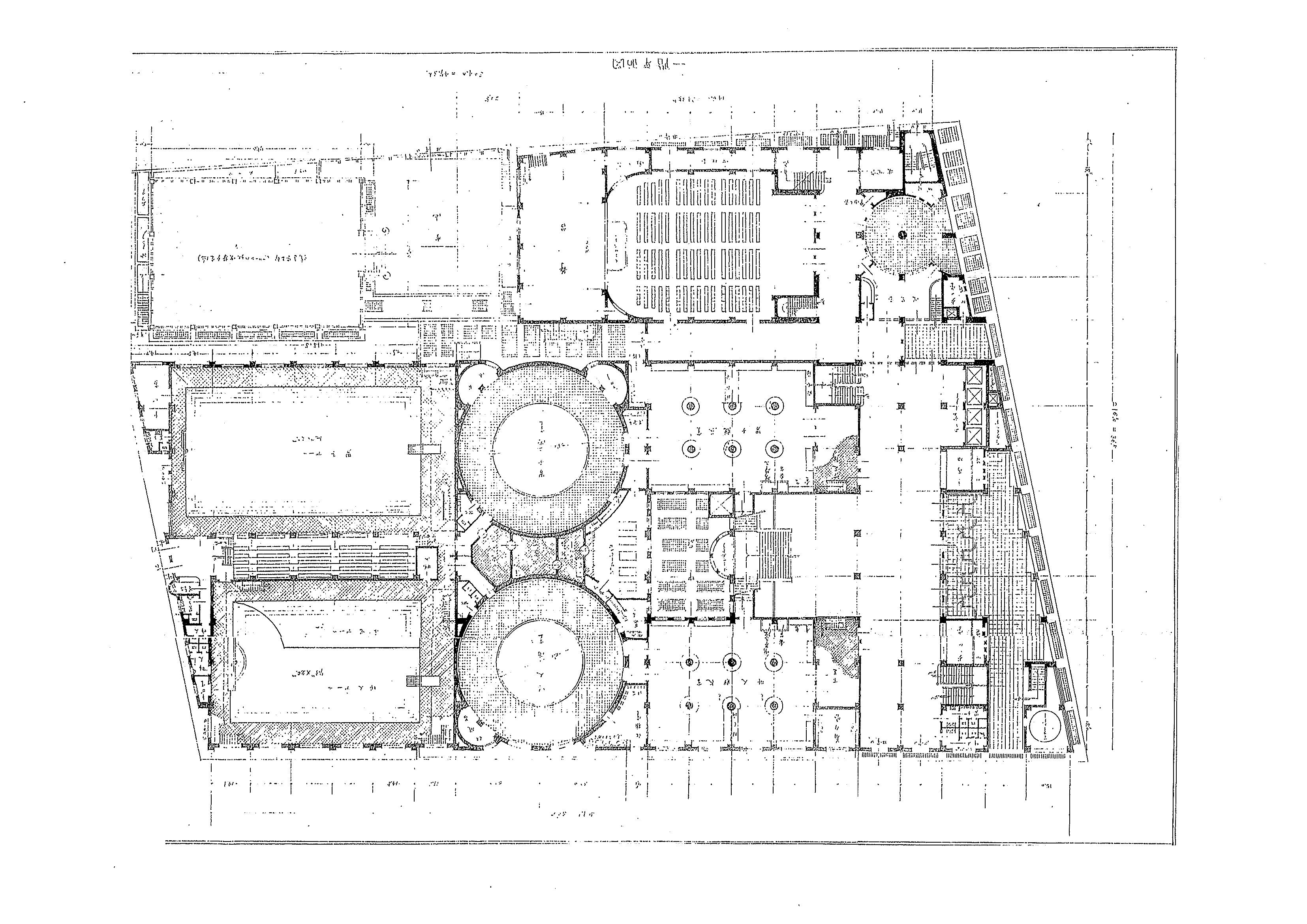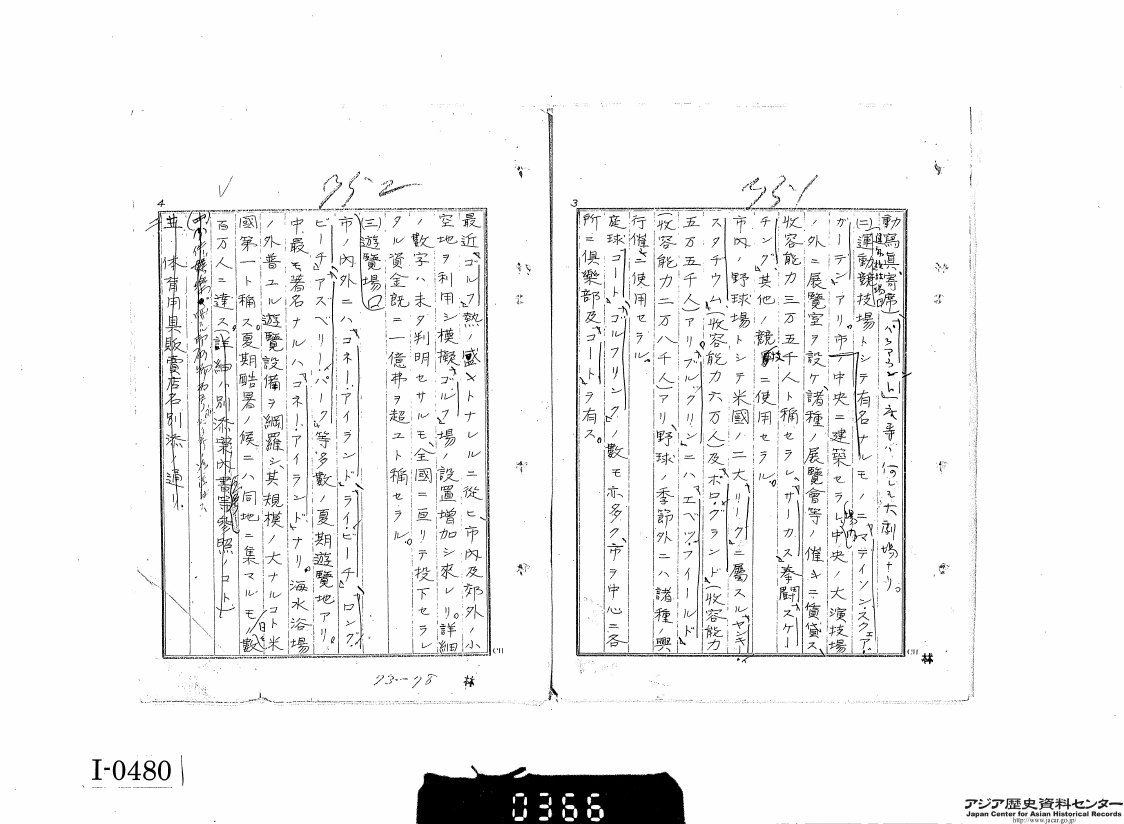JACAR Newsletter Number 30
December 19, 2019
Documents Spotlight
Asakusa Olympia: The Tourist Attraction That Never Was
Introduction
When people think of Tokyo’s Asakusa neighborhood, certain well-known tourist attractions past and present come to mind: Sensō Temple and Hanayashiki amusement park; Engei Hall, where rakugo performances evoke memories of Asakusa Rokku, or “Sixth District,” as the neighborhood’s entertainment precinct was known; Imahan for its sukiyaki and Komakata Dozeu for traditional Japanese cuisine; and the long-gone International Theater (now the site of Asakusa View Hotel) and Japan’s first skyscraper the Ryōunkaku tower. Asakusa’s image is strongly linked to leisure, as this roll call of restaurants, performing arts venues, tourist attractions, and other mass entertainments. And, in fact, if the plans for another project had gone through, Asakusa might well have been known for another such establishment: a massive sports complex planned for 1930 that was to be called Asakusa Olympia.
We can learn about the Olympia complex through a document in the Diplomatic Archives of the Ministry of Foreign Affairs titled, “Kakkoku ni okeru minshū goraku shisetsu chōsa kankei zassan” [Miscellaneous articles related to the survey of mass entertainments and leisure facilities in various countries] (hereafter, “Miscellany”) (Ref.B04012500800). The “Miscellany” comprises three sets of documents regarding the construction and operation of Asakusa Olympia: (1) “Memorandum of Intent on the Founding of Tokyo Athletics Industrial K.K. and New Business Prospectus” (hereafter, “Prospectus”) submitted to the Foreign Ministry by the now-defunct company that was to oversee Asakusa Olympia’s construction; (2) responses from the embassies of France, the U.K., Germany, and the U.S. to a survey of leisure facilities in their respective countries they were asked to put together by Foreign Minister Shidehara Kijūrō; and (3) documents that the Trade Bureau forwarded to Tokyo Athletics after receiving those answers. In the sections that follow, I will look in particular at the “Prospectus” included in the “Miscellany” to introduce what sort of leisure activities they had in mind for the Asakusa Olympia.
1. Asakusa in the Early Shōwa Period and the Asakusa Olympia
(1) Asakusa in the Early Shōwa Period (1926-1930)
In a revision undertaken in 1884 at the behest of local government, Asakusa Park—which had been created on the vast grounds of Sensō Temple—were divided up into six districts. The sixth of these was refashioned to be a nightlife and entertainment district: Asakusa Rokku. Sparked by the building in 1887 of the Tokiwaza theater, Asakusa Rokku developed over the next two decades or so as just such a district with a plethora of theaters, movie houses, opera halls, and the like. Ryōunkaku was built on the north side of Asakusa Rokku in 1890. It was catatrophically damaged in the Great Kantō earthquake of September 1923. A brief passing fad for plays featuring sword-fights developed in the years after the quake. This in turn was followed from around 1929 by the popularity of the Casino Folies, a musical review modeled on such French cabaret troupes as the Folies Bergère. In 1928, Shōchiku had opened its theater the Asakusa Shōchikuza, where its own dancing girl chorus line review the Shōchiku Gakugekidan won audiences over. The theater was also used to show foreign movies, which also became a mass entertainment. Thus, in the early years of the Shōwa Period, Asakusa was in the process of recovering from the Great Kantō earthquake, and resuming development as an entertainment district centered on drama, comic shows, and foreign film.【1】
The Asakusa Olympia project was conceived during this transitional period. The planned construction site for Asakusa Olympia was Shin-Tanimachi 18-banchi, which until the earthquake had been the location of the cemetary connected to Kōryū Temple (Shin-Tanimachi 16-banchi). Since prior to the earthquake, one belt of land neighboring Shin-Tanimachi had been populated by numerous temples.【2】 As talk of how children would play at swordfighting in the graveyard that stood before Kōryū Temple attests to, this neighborhood was woven into the fabric of local residents' day-to-day activities.【3】 Kōryū Temple was damaged in the earthquake. In 1927, it was relocated to the Karasuyama neighborhood in what today is Tokyo’s Setagaya Ward, and the belt of land in Shin-Tanimachi was left vacant.【4】 The plot of land where Kōryū Temple stood was in an excellent location right across a major street from Asakusa Rokku and Asakusa Park (see Image 1). As the entertainment districts recovered, the question arose as to how to make use lot of well-positioned land that had been left vacant due to the earthquake. This was the context in which the Asakusa Olympia concept took shape.
In July 10, 1930 edition of the Yomiuri Shinbun, there appeared an article with the headline: “Sports Palace for Asakusa: ‘Asakusa Olympia’ Construction Plan Has Everything for Getting Exercise.” The article reported that the Olympia was being planned as “a major sports palace” for Asakusa Park that would include a large swimming pool, a training hall for judō and kendō, and spaces for exercise and sports of all sorts. Construction was to begin that September, and the work was to be completed by the end of the next year. Exactly what sort of facility was this “Sports Palace” supposed to be? To learn the answer to that question, let us turn to the Asakusa Olympia “Prospectus.”
 Image 1: Map of the Asakusa Park neighborhood—the Asakusa Olympia site. “Kakkoku ni okeru minshū goraku shisetsu chōsa kankei zassan” [Miscellaneous articles related to the survey of mass entertainments and leisure facilities in various countries] (Ref.B04012500800). Tenth image in the file.
Image 1: Map of the Asakusa Park neighborhood—the Asakusa Olympia site. “Kakkoku ni okeru minshū goraku shisetsu chōsa kankei zassan” [Miscellaneous articles related to the survey of mass entertainments and leisure facilities in various countries] (Ref.B04012500800). Tenth image in the file.
(2) Asakusa Olympia
The Asakusa Olympia was projected to have facilities of various sorts focused on its two main areas of operation: those of sports and of relaxation and leisure.
Highlights among the sports facilities were the grand athletic grounds and the large swimming pools. With a total area of 200 tsubo (approx. 660 ㎡) and outfitted with a viewing gallery, the indoor playing field could accommodate ball-based sports like volleyball and basketball as well as martial arts such as sumo, judō, and kendō. The first floor was to be equipped with large swimming pools for, respectively, men, women, and children (Image 2). The pools were outfitted with various features to make it more pleasant to use; the water and room temperatures were to be maintained at a fixed level and the roof could be opened on days with fair weather. The floor also was to have a 100 tsubo (approx. 330 ㎡) ice skating rink, an area where patrons could enjoy at low cost such pastimes as table tennis and billiards, and a facility to be called the “adult playground” for partaking in quoits, dekki gorufu (“deck golf,” a Japanese indoors game that combines deck shuffleboard with golf), and other amusements.
One Olympia showpiece was to have been the large swimming baths on the first floor. Two round baths for men and women, respectively, measuring from 5- to 6-ken in diameter (approx. 9 to 10.8 meters) were installed, with medicinal baths, sand pools, and so forth arranged around each. The baths were connected to the swimming pools, so patrons could go back and forth between their respective pools and baths (see Image 2).
The women's and men's baths were to be separated by a courtyard, and plans called for performances by an orchestra to be offered there. A theater was slated for a spot next to the baths and pools (see Image 2). The theater could be used for both plays and motion pictures, and there were plans to create in-house opera and comic performing companies. Aside from the theater, the facility would also have a pavilion. The pavilion was to be a place where other kinds of performances than those presented at the theater could be viewed, such as variety performances, dramatic recitations (gidayū), and naniwa-bushi ballad recitations.
Aside from these facilities, there were also plans to offer a variety of other amusements such as rooms for playing go and shogi and others for playing music that patrons would be free to use, a maze, and a hall of wonders.
Olympia’s designers also planned to create amusements for children. These were to include an exhibit space with a program that would change every month, panorama halls and doll museums that would take current and historical events as their themes, and models of an aquarium and of a zoo with replicas of inhabitants that move using electricity.
Another Olympia showpiece were the dining facilities. Two types of dining hall were planned: one type for patrons only and another for patrons and non-patrons alike. The dining halls open to the public were to be built facing the street. The foods and drinks it served would be available for moderate prices. For patrons only, there were larger facilities directly operated by Olympia management, and two types of small halls that could be rented for private functions. All told, Olympia was to have around 20 dining halls of all sizes, and the food they served was to have been typical of the Kantō region were Tokyo is located and the Kansai region that is home to Kyoto, Osaka, and Kobe.
How, then, did Tokyo Athletics—the company in charge of construction—plan to operate this multifaceted leisure complex? To answer this question, we turn to the income and expendtiures budget.
Under that budget, nearly 80% of the income was to be accounted for by entrance fees. The fees were 80 sen per adult and 30 sen per child, with daily admissions forecast to number 8,000 adults and 2,000 children. The company envisioned the facility’s patrons to be tourists who were visiting Asakusa Park. By promoting Asakusa Olympia as another Tokyo tourist attraction and as a prominent feature of Asakusa on par with Asakusa Kannon Temple, they expected that—aided by a forecast expansion of subways and taxis that formed Tokyo’s transportation network—tourists would be drawn to visit the facility.
Regarding income from sources other than admissions, around 5% each was anticipated to come from sports-related fees, theater admissions, and dining hall income. Included in the price of admission to Asakusa Olympia was permission to use free of charge the bathing facilities, music rooms, go and shogi rooms, and the cafes. Tokyo Athletic hoped to increase proceeds by offering a mix of fee-based and free facilities and then charging patrons depending on how and what they used.
Advertising was to provide another source of income alongside admissions and facilities fees. Core to Olympia’s advertising business was to be the use of lit-up signs and illuminations. The concept of illuminated outdoor advertising was then-popular in Europe, and Tokyo Athletic believed advertising revenue from such would provide a satisfactory boost to profits. Accordingly, it planned to set up a bank of lights for advertising use around the rooftop observation tower that companies and businesses would be able to rent for creating illuminated advertisements for their products. The businesses earning money from advertising through lit-up signs and illuminations that would become common in the 1930s in the Kansai region and around Yokohama and Nagoya were still a new area of business for that time.【5】
Another item alongside these lit-up signs and illuminations that I wish to highlight is the show window. Looking at the plans for the first floor, we can see that there are show windows planned for at three places facing the streets. Japanese department stores had been incorporating show windows in their design since around the turn of the century. Show windows functioned as advertising that conveyed news about the latest trends by presenting images of a modern life style to passersby going about their business. Tokyo Athletic expected that with its various illuminations and show windows it would also be a point for learning about the latest trends.
 Image 2: Asakusa Olympia 1st floor floor plan (“Kakkoku ni okeru minshū goraku shisetsu chōsa kankei zassan”[Ref.B04012500800]), composite created from slides 6 through 9.
Image 2: Asakusa Olympia 1st floor floor plan (“Kakkoku ni okeru minshū goraku shisetsu chōsa kankei zassan”[Ref.B04012500800]), composite created from slides 6 through 9.
2 Tokyo Athletic Industrial’s Amusement Facility Concept
(1)Tokyo Athletic and the Sports as Leisure Business
Unfortunately, there is very little information available to us about what kind of entity Tokyo Athletic, the company that came up with the Asakusa Olympia concept, was. In the aforementioned Yomiuri shinbun article, the list of people who founded the company includes businessman and former Tokyo Governor Ichiki Otohiko, politician and philanthropist Nezu Kaichirō, Upper House politician Aoki Nobumitsu, physicist and executive Ōkochi Masatoshi, and petroleum magnate Ogura Tsuenkichi. Thus, we can see that this was an organization built around politicians and industrialists.
As to why Tokyo Athletic came up with this sports-focused leisure business, its objective in a word was the healthy cultivation of the minds and bodies of Japanese through sporting activities. The company pointed out that the Japanese people were at the point where they would watch “the flourishing of passion for sports” in the liveliness of youth sports competitions, but they were unable to fully enjoy it themselves owing to the pressures of being busy with their daily lives and the lack of facilities for doing so. To address this situation, the company decided that it would “build a palace outfitted with both heating and cooling equipment and in particular apparatus to keep the air clean for both men and women [that could be used] in fair weather or foul that would eliminate the time and costs required to travel outside the city.” The company would operate “departments of sports, amusements, and dining halls” to provide its patrons with “inexpensive and attractive places for indulging in sports to their hearts’ content, and wash away the perspiration in great baths.” These operations would be created as a leisure business that responded to the people’s passion for sports. As part of those operations, Tokyo Athletic planned to build the Asakusa Olympia in that selfsame neighborhood visited by so many people for its playhouses, movie theaters, and the glories of Sensō Temple, and make a success in the business of sports as a “new and different” type of leisure activity.
(2)Facilities for Mass Leisure in Japan and the West
Tokyo Athletic used as reference points existing leisure facilities, primarily hot spring spas in western Japan, for the planned construction of Asakusa Olympia. One such facility was Osaka’s Chikkō Ōshio-yu. This hot springs spa opened its doors in 1914 in the Osaka neighorhood of Chikkō. The facility had fresh water, sea water, and hot water baths, as well as a swimming pool in which drawn up by a motor was turned into a waterfall of sorts. It was also outfitted with a restaurant, an entertainment hall where patrons could watch movies and plays, and an open area some 380 tatami mats in size (nearly 700 ㎡) that could accommodate 1,000 people at a time. This mixture of leisure and entertainment offerings under one roof made Chikkō Ōshio-yu one of the preeminent leisure facilities in the city.【6】 We can imagine that the success of this hot springs-focused multifaceted leisure complex in western Japan gave a push to the plan to build Asakusa Olympia.
One other point of reference for Tokyo Athletic was leisure facilities in the West. Shudō Yasuto, a Foreign Ministry commercial secretary based in New York, introduced a variety of leisure facilities in that city in a report sent to Foreign Minister Shidehara Kijūrō titled “Minshū goraku shisetsu chōsahō no ken” [On the matter of surveys of mass entertainments and leisure facilities]. Madison Square Garden, for example, was described as having a sports playing ground as its core business while also engaging in diverse other leisure-related businesseses such as leasing space for exhibitions: “Built in the center of the city, aside from the large performance space at the center of the site there are also exhibition spaces. The facility can be rented for holding all manner of exhibitions and the like. Capacity is 35,000 people. Used for circuses, boxing, skating, and other competitive sports.” (see Image 3) Unfortunately, we do not know to what degree Tokyo Athletic referred to the various embassy surveys. However, the fact that it was aware of leisure facilities elsewhere in the world as it pursued its own project may serve as a crucial starting point for thinking about where the Japanese leisure industry of the day fit in to the bigger picture of the industry around the world.
 Image 3: Kakkoku ni okeru minshū goraku shisetsu chōsa kankei zassan [Miscellaneous articles related to the survey of mass entertainments and leisure facilities in various countries] (Ref.B04012500800). Slide 33. Madison Square Garden is discussed in lines 2 through 6. Also discussed on this page are the baseball stadia Yankee Stadium and Brooklyn’s Ebbets Field.
Image 3: Kakkoku ni okeru minshū goraku shisetsu chōsa kankei zassan [Miscellaneous articles related to the survey of mass entertainments and leisure facilities in various countries] (Ref.B04012500800). Slide 33. Madison Square Garden is discussed in lines 2 through 6. Also discussed on this page are the baseball stadia Yankee Stadium and Brooklyn’s Ebbets Field.Conclusion: The Aftermath of the Asakusa Olympia Project
The plans had been to complete Asakusa Olympia in September 1930. Nothing was built on the site after the project foundered. In May 1935, the movie maker and theater operator Tōhō the following year announced plans to build a large theater at the former site of Kōryū Temple in Shin-Tanimachi that had been slated for Olympia.【7】 However, Tōhō’s competitor Shōchiku countered its advances, and ultimately decided to build the International Theater in that location.【8】 The theater was completed in June 1937 and opened its doors that July 3. The facility was Shōchiku’s largest, with a total floor area of 4,338 tsubo (approx. 14,315 ㎡) and a 5,000-seat capacity.【9】 Thus, this area that would have been home to a “palace of sports” became “the largest theater in the East” and a symbol of popular entertainment for Asakusa.
Acknowledgements
I wish to express my great apprecation to the staff of the Tokyo Metropolitan Library for their guidance on newspaper articles related to Asakusa Olympia and the International Theater, and to the staff of the Local History and Documents Research Office, Taitō Ward Central Library, for their guidance on maps of the Shin-Tanimachi area.
References
【1】 Ishizumi Harunosuke, Asakusa keizaigaku [An economic study of Asakusa] (Tokyo: Bunjinsha, 1933; reprint in Korekushon: Modan toshi bunka [Collection: Modern urban culture], ed. Ichiyanagi Hirotaka, vol. 11, Asakusa no misemono, shūkyōsei, erosu [Asakusa spectacle, religiousness, and eros], Tokyo: Yumani Shobō, 2005); and Tokyo Metropolitan Goverment, Taitō Ward Office, ed., Taitō-ku shi [A history of Taitō Ward], vol. 3, Shakai bunka hen [Society and culture] (Tokyo: Taitō Ward Office, 1966).[↑]
【2】(Tokyo City, Bureau of Communications, ed., Banchi sakai-iri Tōkyō-shi jūgo-kubun zu+ Asakusa-ku zu [Map of Tokyo City’s 15 wards showing lot boundaries:Asakusa Ward map] (Tokyo: Tokyo City Office, 1911; second printing, 1917)). Last accessed: October 11, 2019.[↑]
【3】 Taitō Ward Arts and History Association and Taitō Ward Shitamachi Museum, eds., Korō ga tsuzuru: Shitaya, Asakusa no Meiji, Taishō, Shōwa [Elders write: Shitaya and Asakusa in the Meiji, Taishō, and Shōwa periods], vol. 8 (Tokyo: Taitō Ward Shitamachi Museum, 1993), p. 87.[↑]
【4】 Taitō Ward Shitamachi Museum, ed., Korō ga tsuzuru, vol. 3 (Tokyo: Taitō Ward Shitamachi Museum, 1987), p. 57.[↑]
【5】Shōmei Nippon [Illuminating Japan] (Tokyo: Illuminating Engineering Institute of Japan, 1936; reprint in Korekushon: Modan toshi bunka [Collection: Modern urban culture], ed. Nishimura Masahiro, vol. 21, Modan toshi no denshoku [Illuminated signage in the modern city], Tokyo: Yumani Shobō, 2006); and Kagayaku Nippon, kagayaku neon [Shining Japan, shining neon] (Tokyo: Seidensha seisakusho, 1937; reprint in ibid.).[↑]
【6】(Osaka City, Minato Ward, “1914 (Taishō 3) nen: Chikkō Ōshio-yu kaijō” [1914: Chikkō Ōshio-yu opens], in “Minato-ku no rekishi: Rekishi nenpyō” [Minato Ward history: Historical chronology] ). Last accessed: October 11, 2019.[↑]
【7】“Kōgyō ō Kobayashi no kyodan: Asakusa ni dai eiga dendō” [Bomb from show business king Kobayashi: Giant movie palace for Asakusa], Tokyo Asahi shinbun, May 8, 1935, p. 13, morning edition.[↑]
【8】“Kono gunpai ‘Shōchiku’ e: Yurakuchō no ada o Asakusa de” [This round goes to Shōchiku: Taking on Yurakuchō rival in Asakusa], Yomiuri shinbun, September 9, 1935, p. 7, morning edition.[↑]
【9】 “Kokusai Gekijō shinchiku gahō” [Illustrated new construction report on the International Theater], Kenchiku setsubi [Architectural equipment], vol. 5, no. 10, 1937.[↑]


